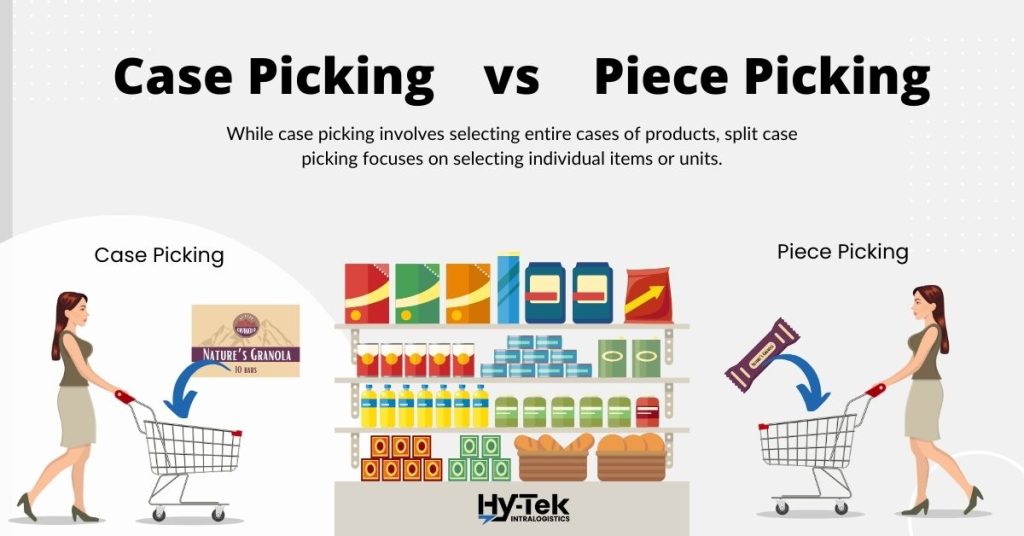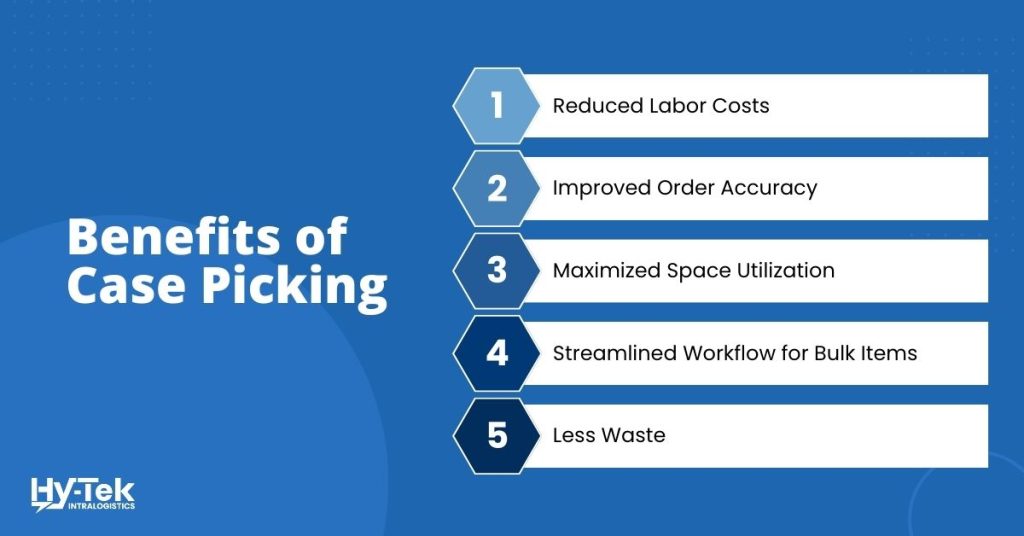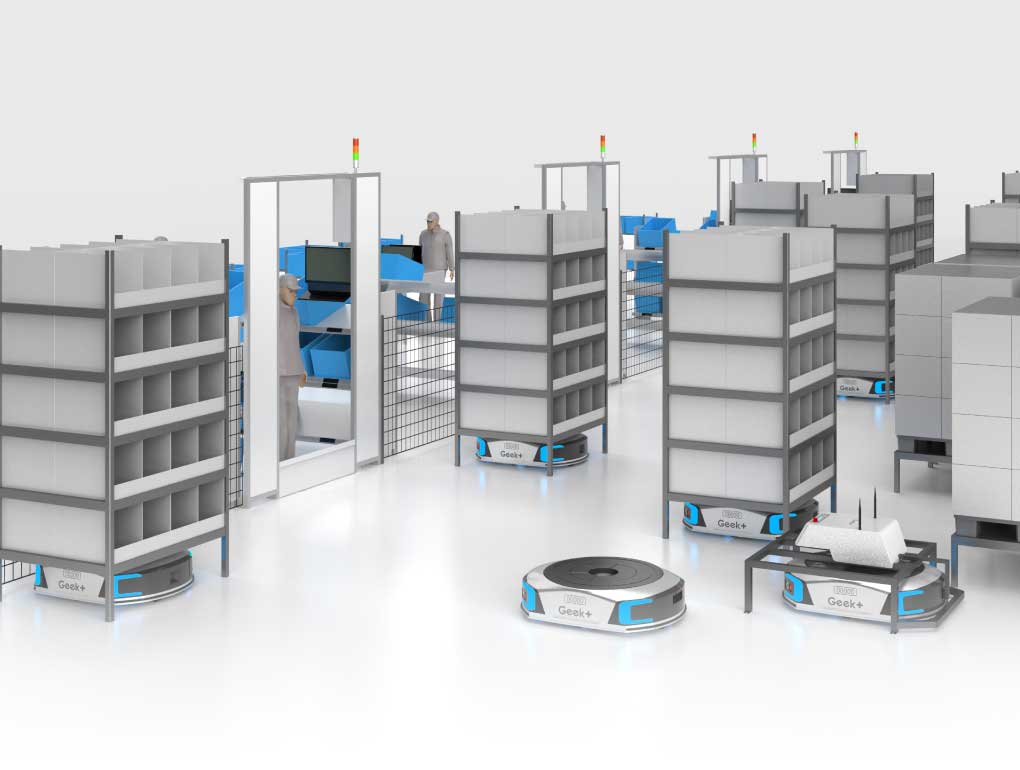Case picking is just one of many types of order-picking methods that warehouses or distribution centers can deploy.
In this blog post, we’ll examine the details of case picking, its impact on productivity, and the industries that can benefit by integrating these systems into their logistics processes.
Whether you’re in retail, e-commerce, manufacturing, or distribution, grasping the advantages of case picking is vital for staying competitive in today’s business environment.
What is Full Case Picking?
First, a “case” is a single carton of a bulk number of items (typically the same SKU).

Full case picking is a type of order picking that involves selecting full cartons from various types of storage locations: shelf storage, pallets on the floor, pallet rack, etc. The full cases are placed on a conveyor, cart, pallet jack, or lift truck.
A good example of case picking that we can all understand is shopping at the grocery store – when you go to the grocery store and pick a box of granola bars from the shelf and place it into your cart, you are case picking.
Case Picking vs. Piece Picking
In contrast to case picking, piece picking or “split case picking” would be if you opened the box of granola bars at the grocery store and took one out, placing it in your cart.
While case picking involves selecting entire cases of products, split case picking focuses on selecting individual items or units.

Case picking is more efficient when dealing with bulk orders, whereas piece picking is better suited for smaller orders or when a high level of customization is required.
When a warehouse receives an order for multiple cases of a specific product, full-case picking comes into play. Instead of picking individual items, warehouse personnel select complete cases that match the order requirements. These cases are then transported directly to the shipping area, ready for distribution.
Industries that utilize case picking
- Retail
- E-commerce
- Grocery and Food Distribution
- Apparel and Fashion
- Electronics
- Pharmaceuticals and Healthcare
- Automotive Parts
- Wholesale Distribution
- Consumer Goods
- Logistics and Third-Party Fulfillment
- Big Box Store Suppliers
5 Key Benefits of Full Case Picking
Using full case picking in a warehouse operations can significantly increase efficiency and reduce costs. It decreases the labor needed for picking individual items and minimizes errors. More than that, it can enhance space utilization and streamline the whole workflow.

By implementing full case picking, warehouses can optimize their operations in several ways:
1. Reduced Labor Costs:
Full case picking eliminates the need to pick individual items, saving time and reducing labor costs. Instead of spending valuable resources on picking each item separately, warehouse personnel can focus on efficiently selecting and moving complete cases.
2. Improved Order Accuracy:
Picking individual items can be prone to errors, leading to incorrect order fulfillment. Full case picking minimizes the chances of mistakes, as the entire case is picked and shipped as a unit.
3. Enhanced Space Utilization:
Full case picking allows for better utilization of warehouse space. Instead of storing individual items, which may require more storage shelves or bins, complete cases can be stacked efficiently.
4. Streamlined Workflow for Bulk Items:
By adopting full case picking, warehouses can streamline their overall bulk item workflow. Warehouse personnel can quickly locate and transport complete cases to the shipping area, reducing handling time and increasing order processing speed.
5. Less Waste:
Full case picking is very efficient because you don’t have to open the case, meaning that there is no empty carton to dispose of.
Strategies to Maximize Full Case Picking Efficiency
So, how can full case-picking efficiency be maximized? There are several key strategies to consider.
1. Implementing Warehouse Management Systems:
With a good Warehouse Management System (WMS), full case picking can be significantly enhanced. A WMS aids in inventory tracking, optimizing pick routes and automating processes, all contributing to efficiency.
2. Training and Development for Warehouse Staff:
Training the warehouse staff in the best practices for full case picking can substantially improve efficiency and reduce picking errors.
3. Optimizing Warehouse Layout for Full Case Picking:
An optimized warehouse layout and pick paths can drastically enhance full case-picking efficiency. It should ensure easy access to products, smooth workflow, and minimal picking travel time.
4. Implementing Systems to Facilitate Case Pick:
A picker can pick a carton directly to a conveyor which is known as a “slapper line” to industry gurus. This is because a picker prints a roll of shipping labels, slaps a label on the case, and places the full carton onto a conveyor which conveys it directly to a shipping dock for truck loading.
5. Inventory Slotting: An optimized inventory slotting strategy would take into consideration things like
- Storage density requirements
- FIFO & LIFO
- ABC Analysis
- Proximity to shipping areas
- Seasonal adjustments
Types of Storage Mediums for Case Picking Operations
There are many types of rack shelf storage that can facilitate your case picking process.
- Selective Pallet Racking:
- Description: Adjustable pallet racks that allow direct access to every pallet position.
- Suitability: Ideal for warehouses with a high variety of products and a low volume of each SKU.
- Double-Deep Racking:
- Description: Pallet storage racks with two pallets stored in-depth, providing higher storage density.
- Suitability: Suited for warehouses with a moderate SKU range and relatively high volume.
- Push-Back Racking:
- Description: Pallets are loaded from one side, and as new pallets are added, the previous ones are pushed back.
- Suitability: Efficient for Last-In, First-Out (LIFO) inventory systems and when dealing with multiple SKUs.
- Carton Flow Rack Storage:
- Mezzanine Storage Systems:
- Description: Multi-level platforms for storage, creating additional space for case picking.
- Suitability: Suitable for warehouses with limited floor space and a need for vertical storage expansion.
- Automated Storage and Retrieval Systems (AS/RS):
- Description: Automated systems that use robots or cranes to retrieve and store pallets or cases.
- Suitability: High-volume operations where speed and efficiency are critical.
- Warehouse Management System (WMS):
- Description: Software that optimizes storage, picking, and inventory management processes.
- Suitability: Essential for coordinating and optimizing full case-picking operations within the warehouse.
- Conveyor Systems:
- Description: Automated systems that move cases from storage to picking areas.
- Suitability: Efficient for large warehouses with a continuous flow of products.
Conclusion
Case picking is a crucial operation in order fulfillment and warehousing.
Understanding the key elements, distinctions, and best practices surrounding case picking will empower warehouse and operations managers to optimize their processes, enhance customer satisfaction, and remain competitive in a rapidly evolving supply chain landscape.
By applying the right strategies, embracing automation, and fostering a culture of continuous improvement, your warehouse can achieve mastery in the art of case picking.







